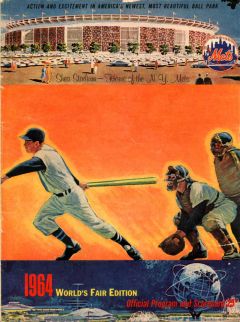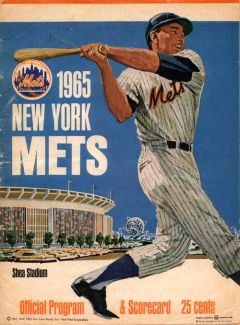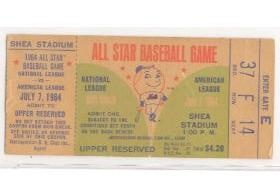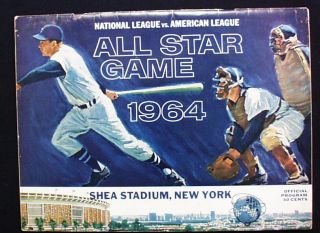Of the few permanent structures that opened
in Flushing Meadow in April 1964, the one that was intended as
the greatest long-term legacy lay just outside the Fair's Main
Entrance, across a walkway and parking lot: Shea Stadium, the
brand new home of both the New York Mets baseball team
and New York Jets (formerly Titans) AFL football
team.
It was only coincidence caused by construction
delays that saw Shea Stadium open at the same time the World's
Fair did. The original planning had called for it to be ready
the previous season (the Mets had even held a farewell
to the Polo Grounds ceremony at the end of the 1962 season and
then were forced to do it again at the end of 1963). In many
ways the timing worked out perfectly as it allowed Shea to stand
out as part of the aura of dynamic Space Age progress that the
Fair symbolized. Shea Stadium was the first new stadium for New
Yorkers in more than 40 years and it epitomized all the things
that Yankee Stadium, the Polo Grounds and Ebbets Field were not.
At Shea a spectator could finally, for
the first time, not have to worry about getting a seat with an
obstructed view caused by a support post, that for all ballparks
built before the 1950s was a necessary evil in order to accommodate
a multi-level facility. At Shea a suburban visitor could make
use of an ocean of available parking space for his car, something
that wasn't available at Yankee Stadium or either of the bygone
ballparks. And at Shea a visitor from the more upscale suburban
communities could see a game without the uneasy feeling that
he had put his safety at risk by coming to a game in a deteriorating
neighborhood.
Yankee Stadium, Ebbets Field and the Polo
Grounds had all been built in the early decades of the 20th Century
in what had been middle-class urban neighborhoods with thriving
homes and businesses surrounding the ballpark environs. The Concourse
Plaza Hotel, located just beyond Yankee Stadium, was regarded
as a luxury hotel and served as the in-season home for most of
the ballplayers. But by the 1950s these once middle-class communities
were spiraling into a state of decay and neglect caused largely
by the changing demographics of post-World War II America. The
great highways of the future predicted by the original New York
World's Fair of 1939 had brought with them an exodus of the middle-class
from traditional urban neighborhoods to new homes in the emerging
suburbs that enabled a person to live in more quiet, pastoral
settings while still working in the city. The departure of the
middle-class meant that those from the lower classes inevitably
moved into the abandoned neighborhoods. In the space of two decades
urban decay had settled in, with a marked increase in crime in
the very neighborhoods that housed New York's three venerable
ballparks.
Despite the fact that from 1947-1956, all
three teams were dominating baseball like never before (the Yankees
won eight pennants and seven championships in that span, the
Dodgers six pennants and a championship, and the Giants two pennants
and a championship), attendance seldom rose above more than one
and a quarter million for any of the New York teams after 1950.
Inevitably, the blame was fixed on the deteriorating neighborhoods,
which to a suburban fan took on added weight since he could now
stay at home and watch a game on television without having to
travel to a run-down community. Ultimately, for the Brooklyn
Dodgers and New York Giants, their belief that New York would
never build a new stadium in a better neighborhood that could
draw more fans led them to abandon New York for the untested
regions of California after the 1957 season.
New York tried its best to convince the
Dodgers, at least, that they could get a new ballpark that, while
not situated in Brooklyn itself, would be located close enough
to their natural fan base to allow for suburban fans from Long
Island to make the trip with a greater sense of security. New
York's Parks Commissioner Robert Moses had long viewed the construction
of a stadium in Flushing Meadow as one of the keys toward achieving
the rehabilitation of the site that had not taken place after
the closing of the 1939-40 World's Fair. On April 10, 1957, he
put forth a proposal to Dodger owner Walter O'Malley that called
for $12 million of city funds for a new facility in Flushing
Meadow that would satisfy the Dodgers needs for larger seating
(Ebbets Field was a bandbox in size, seating no more than 35,000
which often meant smaller revenue streams during the many World
Series the Dodgers participated in during the 1950s), safe parking
away from any deteriorating neighborhood and access to a public
transportation line that could bring fans to the stadium by subway.
O'Malley, however, was never interested
in Flushing Meadow as a site for a new ballpark. His obsession
centered on a piece of land at the corner of Atlantic and Flatbush
Avenues in Brooklyn where he wanted to build a large domed stadium
out of his own pocket. He needed to get the city to turn over
the land to him and on this, both New York mayor Robert Wagner
and Robert Moses, the two allies O'Malley needed, adamantly refused
since it would have meant removing land from the city's tax rolls
for O'Malley's use and would have put O'Malley in position to
reap the rewards of development in the area immediately adjacent
to the new ballpark. Irving Rudd, who worked for the Dodgers
during this time as promotions director, later put it succinctly
to author Peter Golenbock "If they had given O'Malley what
he wanted, they should have gone to jail."
Oddly, there is no indication that Moses
and Wagner ever thought of using Flushing Meadow as an opportunity
to keep the Giants in New York once it was clear that O'Malley
wasn't going to move the Dodgers to Queens (In rejecting the
proposal, O'Malley said that if the Dodgers moved out of Brooklyn,
even to Queens, it would be no different than moving to California.
Many Brooklyn fans would certainly have taken exception to that).
By that point Giants owner Horace Stoneham was so determined
to leave New York (where he had real financial problems) that
no doubt Moses and Wagner realized it would have been a futile
gesture.
And so when the 1958 baseball season opened
New York suddenly found itself reduced from three baseball teams
to one. Almost immediately there was a clamor from city officials
to get baseball to bring a National League team back to New York
since it was clear that the deprived Dodger and Giant fans would
not be swallowing their pride to become Yankee fans. But since
no National League team was interested in relocating to New York
and because there had never been an expansion of the league in
the 20th Century, it seemed that such appeals would forever fall
on deaf ears. What finally got Major League Baseball to do an
about-face and bring the National League back to New York was
the sudden threat of an independent third league forcing its
way into the big time.
The proposed Continental League was the
brainchild of New York attorney Bill Shea who, after failing
to convince an established National League team to move to New
York, decided to take action by organizing a proposed third league
with franchises based in New York, Houston, Denver, Toronto and
other cities without a Major League team. It was Shea who found
a solid financial backer for the proposed New York franchise
in Joan Whitney Payson, a former Giants minority stockholder.
And with the presence of former Dodger General Manager Branch
Rickey as President of the proposed league, it was clear that
this endeavor was determined to succeed. Both the American and
National League decided it would be easier to compromise and
accommodate some of the proposed Continental franchises through
an expansion of both leagues in 1961 and 1962. New York would
be added to the National League under the formula starting in
1962.
Once New York had been approved, Mayor
Wagner and Robert Moses wasted little time in dusting off the
Flushing Meadow proposal for the new stadium that Walter O'Malley
had rejected. By this point, Moses was already beginning his
preparations for the overall rehabilitation of Flushing Meadow
by a new World's Fair and the opportunity to further improve
the park's long-term health with a stadium could only be a godsend.
The New York legislature passed a bond measure that would pay
for the construction costs and, on October 6, 1961, the new team,
officially called the "Metropolitans" but from the
outset referred to as "Mets", signed a 30 year lease
to play in the new stadium. Not long afterwards the American
Football League's New York Titans, which had come into existence
with the renegade football league in 1960 and played their games
in the Polo Grounds, signed on to play in the new stadium as
well. The Flushing Meadow stadium would now have almost total
year-round use.
The decision was made to name the new stadium
in honor of Bill Shea recognizing that without his efforts to
propose the Continental League, New York would never have received
a second team again and the stadium would not exist. It was a
very rare case where a new stadium's name was not tied to either
location (such as San Francisco's Candlestick Park), a club owner
or executive (Ebbets Field had been named for the Dodgers then-owner
when it opened in 1912), or the team itself (Yankee Stadium).
For many years afterwards Mets fans entered Shea Stadium with
little idea of the man who the stadium had been named for. In
a Mets team history video in 1985, Bill Shea chuckled as he recalled
one occasion when he visited the ballpark not long after it opened,
"There were two fans in front of me and one of them was
asking, 'Who the heck was that guy Shea they named the place
after?' And the other guy said, 'Oh, he was a ballplayer that
was killed in the First World War.'"
If there was anyone else who could have
conceivably earned the right to have the stadium named after
him, it would have been Robert Moses. The Flushing Meadow site
had been his brainchild as part of his overall vision to see
Flushing Meadow Park transformed into a "super urban park,"
providing more convenience to the increasingly suburban tilt
of New York's population that was moving eastward into Long Island.
Once it was clear that National League baseball would be returning
to New York, no thought was given to any other location than
Moses'. And because Shea's opening would ultimately coincide
with the 1964 World's Fair that was, unrealistically, expected
to attract 70 million visitors, it seemed only natural to think
that building Shea in the same location would help enhance Fair
attendance.
Official Met's Program and Scorecard
for the 1964 (l.) and 1965 (r.) Seasons. The Fair and Shea Stadium
were in each other's best interests in '64 and '65.
|

|
|
 |
We can never know for certain how many
visitors to Shea that first year also took advantage of the Fair's
proximity. But in that first season of 1964 the Mets drew 1.7
million in attendance, nearly doubling the numbers they had drawn
to the decaying Polo Grounds in 1962 and 1963. The new locale
didn't improve their inept playing but for the first time the
Mets began to look like the team of the future which fit in nicely
with the theme of the "Space Age" World's Fair. 1964
saw the emergence of their first homegrown player, second baseman
Ron Hunt, who was elected to the 1964 All Star Game (played at
Shea, and won by the NL on a dramatic game ending home run by
Johnny Callison of the Phillies), while the following year saw
outfielder Ron Swoboda, later a key member of the 1969 "Miracle
Mets" championship team, burst on the scene and set a rookie
record for home runs in a month.
1964 All Star Game ticket and
Souvenir Program
 |
 LISTEN ! - From the original NBC
Radio broadcast: Philadelphia's Johnny Callison hits a game-ending
home run to win the 1964 All Star Game at Shea Stadium for the
National League, 7-4. (Blaine Walsh, announcer). LISTEN ! - From the original NBC
Radio broadcast: Philadelphia's Johnny Callison hits a game-ending
home run to win the 1964 All Star Game at Shea Stadium for the
National League, 7-4. (Blaine Walsh, announcer).
 |
By contrast, the mighty Yankees dynasty
that had won fifteen American League pennants in eighteen years
since 1947 was beginning to crumble. In 1964 the Bronx Bombers
of Mickey Mantle, Roger Maris and Whitey Ford had to rally from
far back to win one last pennant before bowing out to the St.
Louis Cardinals in the World Series. The next year, age and injury
set in at once and the Yankees collapsed to sixth place, followed
by a last place finish in 1966. During the second year of the
Fair, New Yorkers now had a choice between an aged declining
team playing in an increasingly dated facility in a bad neighborhood
and a team that, while losing, was injecting more and more youth
into the mix and playing in a comfortable modern facility. It
was no contest and the Mets finally became the undisputed focal
point of baseball in New York -- a status they would enjoy through
their championship in 1969 and well into the 1970s before bad
ownership decisions and the dawn of free agency sent them in
a tailspin while the simultaneous rebirth of the Yankees
in a modernized Yankee Stadium in 1976 shifted the focus back
to the Bronx Bombers as New York's premier team.
Today, nearly forty years after it first
opened as the symbol of what the "Space Age" World's
Fair was all about, Shea Stadium is the third oldest National
League ballpark still in use trailing only Chicago's venerable
Wrigley Field and Dodger Stadium in Los Angeles (which opened
in 1962). The impulse to build stadiums away from urban neighborhoods
and in more outlying communities has long since passed with the
emphasis now on building smaller "classic" style ballparks
in downtown urban locations in the hope that they will bring
a larger economic and cultural revitalization of the community.
In effect, the vision that Walter O'Malley wanted to prevail
in his Atlantic Avenue site for a ballpark in Brooklyn has now
come to pass in such cities as Baltimore, Cleveland and Denver.
By contrast, Shea Stadium, situated in a sea of parking lots
across from a park that after the Fair's closing still failed
to fully live up to what Robert Moses had envisioned, has become
the kind of quaint relic from the past that Yankee Stadium, the
Polo Grounds and Ebbets Field seemed in 1964. Several repaintings,
and the partial enclosure of the outfield caused by two giant
"Diamond Vision" screens, have only served as cosmetic
attempts to conceal its age. The departure of the New York Jets
football team for the New Jersey Meadowlands in 1984 further
underscored Shea's inability to maintain the aura of up-to-date
sophistication it projected during its first two years when the
Fair was in full swing.
Today, when visitors come to Shea, they
do so in general ignorance of why the stadium is so-named. And
even if they look beyond the parking lots and see the nearby
Unisphere they might not fully recognize how both structures
are indelibly linked to the vision of one man, Robert Moses,
to transform Flushing Meadow into the last word on urban park
development. But so long as the Mets continue to play
in Flushing Meadow, even if in a new stadium built one day on
the other side of the parking lots, that part of the Robert Moses'
vision will continue to endure.
* * *
|